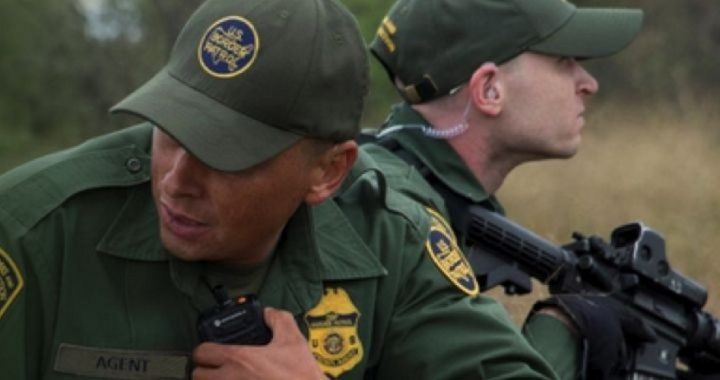
On Tuesday, John Kelly, secretary of the Department of Homeland Security (DHS), released two memoranda dealing with the Trump administration’s policy to follow and enforce the laws regarding illegal immigration. In this article, The New American takes an in-depth look at the first of those memos.
That memo, “Implementing the President’s Border Security and Immigration Enforcement Improvements Policies,” begins with an introduction which states that the memo “implements the Executive Order entitled ‘Border Security and Immigration Enforcement Improvements,’ issued by the President on January 25, 2017, which establishes the President’s policy regarding effective border security and immigration enforcement through faithful execution of the laws of the United States.” Unlike most executive orders to which Americans have become accustomed, the executive order on which this memo is based is within the constitutional bounds of presidential authority.
After all, the president’s oath of office requires that he “faithfully execute” the duties of that office, and perhaps the chief duty to which he is held is the execution of federal laws. Just because Americans have gotten used to seeing presidents ignore federal immigration laws is no reason not to begin following and enforcing them now.
In fact, the memo — which clearly explains the implementation of that executive order to change American policy in dealing with illegal immigration — makes it very clear that this policy change is about following and enforcing existing immigration laws. Section A. — which appears just after the introduction — is subtitled, “Policies Regarding the Apprehension and Detention of Aliens Described in Section 235 of the Immigration and Nationality Act” and is replete with references to that section of federal law.
Because U.S. Customs and Border Protection (CBP) is charged with the responsibility of enforcing laws regarding illegal border crossings, but “has insufficient agents/officers to effectively detect, track, and apprehend all aliens illegally entering the United States,” the memo authorizes — and requires — the commissioner of CBP to:
immediately begin the process of hiring 5,000 additional Border Patrol agents, as well as 500 Air & Marine Agents/Officers, subject to the availability of resources, and take all actions necessary to ensure that such agents/officers enter on duty and are assigned to appropriate duty stations, including providing for the attendant resources and additional personnel necessary to support such agents, as soon as practicable.
Besides “the availability of resources” — which will be left up to Congress to provide — the only other major condition this section gives is that the hiring must be done “while ensuring consistency in training and standards.” Unless the Republican-controlled Congress fails to fund this hiring program, the United States will soon have ample numbers of sufficiently trained and equipped agents and officers to protect our borders. And those agents and officers will be allowed to do so.
The memo also requires “the heads of all executive departments to identify and quantify all sources of direct and indirect Federal aid or assistance to the Government of Mexico” to be overseen by the undersecretary for management who “shall identify all sources of direct or indirect aid and assistance, excluding intelligence activities, from every departmental component to the Government of Mexico on an annual basis, for the last five fiscal years, and quantify such aid or assistance” in a report to DHS Secretary Kelly within 30 days.
Such an analysis may well be the precursor to the end of the gravy train of U.S. funds going into Mexico at the same time that real border enforcement would mean the end of the wagon train of illegal immigrants coming into the United States.
Toward the goal of stopping that wagon train of illegal immigration, the memo also commissions “an immediate comprehensive study of the security of the southern border” in an effort “to identify vulnerabilities and provide recommendations to enhance border security.” The memo requires that the study “include all aspects of the current border security environment, including the availability of federal and state resources to develop and implement an effective border security strategy that will achieve complete operational control of the border.” It further orders that the “Undersecretary of Management, in consultation with the Commissioner of CBP shall immediately identify and allocate all sources of available funding for the planning, design, construction and maintenance of a wall, including the attendant lighting, technology (including sensors), as well as patrol and access roads, and develop requirements for total ownership cost of this project, including preparing Congressional budget requests for the current fiscal year (e.g., supplemental budget requests) and subsequent fiscal years.”
Even as border security is in the process of being brought into the 21st century, real enforcement will begin. Since “it is in the national interest to detain and expeditiously remove from the United States aliens apprehended at the border, who have been ordered removed after consideration and denial of their claims for relief or protection,” the memo states that — with exceptions permitted or required by existing laws:
Pursuant to section 235(b)(l )(A)(i) of the INA, if an immigration officer determines that an arriving alien is inadmissible to the United States under section 212(a)(6)(C) or section 212(a)(7) of the INA, the officer shall, consistent with all applicable laws, order the alien removed from the United States without further hearing or review.
To explain the value of expediting the process of removing illegal aliens as soon as they are apprehended, Secretary Kelly wrote in the memo:
The surge of illegal immigration at the southern border has overwhelmed federal agencies and resources and has created a significant national security vulnerability to the United States. Thousands of aliens apprehended at the border, placed in removal proceedings, and released from custody have absconded and failed to appear at their removal hearings. Immigration courts are experiencing a historic backlog of removal cases, primarily proceedings under section 240 of the INA for individuals who are not currently detained.
During October 2016 and November 2016, there were 46,184 and 47,215 apprehensions, respectively, between ports of entry on our southern border. In comparison, during October 2015 and November 2015 there were 32,724 and 32,838 apprehensions, respectively, between ports of entry on our southern border. This increase of 10,000-15,000 apprehensions per month has significantly strained DHS resources.
In short, the abandonment of executing the law for at least the last eight years has created a losing battle for those tasked with stemming the rapidly growing tide of illegal aliens. President Trump’s shift in policy toward enforcing the law comes none too soon.
Given the gargantuan proportions to which this problem has been allowed (if not manufactured) to grow, federal agents and officers alone will not be able to bring it under control. Whereas under the Obama administration, local and state police were discouraged — if not outright forbidden — to enforce immigration laws, this memo expands a program known as 287(g). This program allows the secretary of DHS to “enter into a written agreement with a state or political subdivision thereof, for the purpose of authorizing qualified officers or employees of the state or subdivision to perform the functions of an immigration officer in relation to the investigation, apprehension, or detention of aliens in the United States.”
As Secretary Kelly wrote in the memo:
Empowering state and local law enforcement agencies to assist in the enforcement of federal immigration law is critical to an effective enforcement strategy. Aliens who engage in criminal conduct are priorities for arrest and removal and will often be encountered by state and local law enforcement officers during the course of their routine duties. It is in the interest of the Department to partner with those state and local jurisdictions through 287(g) agreements to assist in the arrest and removal of criminal aliens.
To that end, Kelly wrote in the memo that he is “directing the Director of ICE and the Commissioner of CBP to engage immediately with all willing and qualified law enforcement jurisdictions that meet all program requirements for the purpose of entering into agreements under 287(g).”
With better border security facilitated by modern, effective equipment and structures and carried out by ample numbers of sufficiently trained and equipped agents and officers who will be assisted by willing and qualified police officers and deputies who will have the authority to remove illegal aliens from the United States without further hearing or review, America may be well on her way to real national security.




